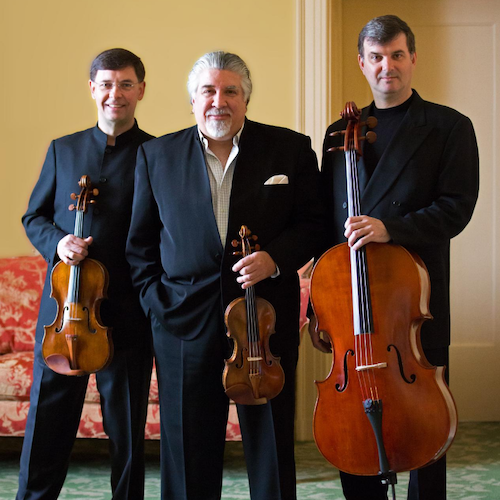Díaz Trio closes FOCM season with an afternoon of delightful early Beethoven
Beethoven’s string trios proved the perfect soundtrack to a humid Sunday afternoon as Friends of Chamber Music concluded its season with the Díaz Trio at Florida International University’s Wertheim Performing Arts Center.
These early Beethoven scores find the composer strongly under the influence of Haydn. An ocean separates the trios from the late string quartets and piano sonatas. Hearing two trios gave a vivid glimpse of Beethoven’s first creative awakenings and the monumental journey he was to make. Although conceived in the form of light entertainment music, the string trios are clearly the work of a major composer, encompassing Beethoven’s mastery of thematic invention and scoring for string instruments.
The Díaz threesome (violinist Andrés Cárdenes, violist Roberto Díaz and cellist Andrés Díaz) combined smooth polish with gutsy, vivacious articulation, providing just the right insight and spontaneity to bring out the spirited charm of Beethoven’s initial chamber music efforts.
The String Trio in E-flat, Op. 3, published in 1794, is actually a divertimento. Lively and replete with an enticing flow of inspired melody, the six-movement confection displayed the players’ expert teamwork, astute blending and unity of execution. Cárdenes’ vigorous attack and patrician phrasing stood out in the first movement Allegro con brio. Transitions were beautifully conveyed without losing the music’s driving pulse. The distinctive tone and depth of Roberto Díaz’s viola were strongly evident. Individual instrumental voices emerged with transparency while combining seamlessly to sound as one.
The Adagio unfurls one of Beethoven’s first great melodic inspirations and the silky interplay of violin and viola lines warmly enveloped and matched the section’s beauty. In the Menuetto and Allegro finale, robust energy and incisive realization of the contrasting stormy interludes alternated to strong effect. From first bar to last, the entire reading was an utter delight.
The String Trio in G major, Op. 9, no. 1 (from 1797-98) is a more mature and structurally coherent composition. The intricacies of the slow introduction and invigorating motifs of the Allegro were given finely nuanced coloration and dynamic variety. The main subject of the Adagio ma non tanto e cantabile received detailed voicing, the musicians’ silken textures complimenting the expressive richness that would lead to the new romantic era.
A shapely traversal of the Scherzo gave full rein to the movement’s wit and quirky paths. In the trio section, the cello has a major role and Andrés Díaz’s rich tonal sheen took full flight. Fine ensemble playing and lithe precision imbued the concluding Presto with joy and effervescence. This was a wonderful matinee musicale, combining rare Beethoven with top-drawer musicianship.
The 2022-2023 season of Friends of Chamber Music opens with pianist Vadym Kholodenko November 2 at FIU Wertheim Auditorium. miamichambermusic.org
Posted in Performances
Leave a Comment
Mon May 23, 2022
at 12:33 pm
No Comments
